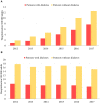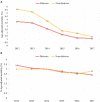Trends and Outcomes of Aortic Valve Replacement in Patients With Diabetes in the US
- PMID: 35369344
- PMCID: PMC8971926
- DOI: 10.3389/fcvm.2022.844068
Trends and Outcomes of Aortic Valve Replacement in Patients With Diabetes in the US
Abstract
Aims: We aimed to assess the trend and outcome of aortic valve replacement in patients with diabetes.
Background: Diabetes is associated with higher cardiovascular events.
Methods: Data from the National Inpatient Sample was analyzed between 2012 and 2017. We compared hospitalizations and in-hospital cardiovascular outcomes in patients with diabetes to those without diabetes, hospitalized for aortic valve replacement.
Results: In diabetes patients undergoing TAVR, the mean age of participants decreased from 79.6 ± 8 to 67.8 ± 8, hospitalizations increased from 0.97 to 7.68/100,000 US adults (p < 0.002 for both). There was a significant temporal decrease in mortality, acute renal failure (ARF), and stroke. Compared to non-diabetic patients, those with diabetes had a higher risk of stroke, ARF, and pacemaker requirement [adjusted OR = 1.174 (1.03-1.34), 1.294 (1.24-1.35), 1.153 (1.11-1.20), respectively], but a similar adjusted mortality risk. In diabetes patients undergoing sAVR, the mean age of participants decreased from 70.4 ± 10 to 68 ± 9 (p < 0.001), hospitalizations dropped from 7.72 to 6.63/100,000 US adults (p = 0.025), so did mortality, bleeding, and ARF. When compared to non-diabetes patients, those with diabetes were older and had a higher adjusted risk of mortality, stroke, and ARF [adjusted OR= 1.115 (1.06-1.17), 1.140 (1.05-1.23), 1.217 (1.18-1.26); respectively].
Conclusion: The recent temporal trend of aortic valve replacement in patients with diabetes shows a significant increase in TAVR coupled with a decrease in sAVR. Mortality and other cardiovascular outcomes decreased in both techniques. sAVR, but not TAVR, was associated with higher in-hospital mortality risk.
Keywords: SAVR; TAVR; aortic stenosis; aortic valve repair; diabetes.
Copyright © 2022 Khan, Dargham, Al Suwaidi, Jneid and Abi Khalil.
Conflict of interest statement
The authors declare that the research was conducted in the absence of any commercial or financial relationships that could be construed as a potential conflict of interest.
Figures




Similar articles
-
Temporal Trends and Outcomes of Transcatheter Versus Surgical Aortic Valve Replacement for Bicuspid Aortic Valve Stenosis.JACC Cardiovasc Interv. 2019 Sep 23;12(18):1811-1822. doi: 10.1016/j.jcin.2019.06.037. JACC Cardiovasc Interv. 2019. PMID: 31537280
-
Comparing Trajectory of Surgical Aortic Valve Replacement in the Early vs. Late Transcatheter Aortic Valve Replacement Era.Front Cardiovasc Med. 2021 Jun 22;8:680123. doi: 10.3389/fcvm.2021.680123. eCollection 2021. Front Cardiovasc Med. 2021. PMID: 34239904 Free PMC article.
-
Transcatheter and Surgical Aortic Valve Replacement Outcomes for Patients with Chronic Heart Failure.J Cardiothorac Vasc Anesth. 2021 Mar;35(3):888-895. doi: 10.1053/j.jvca.2020.06.082. Epub 2020 Jul 3. J Cardiothorac Vasc Anesth. 2021. PMID: 32718887
-
Transcatheter aortic valve replacement versus surgical aortic valve replacement in low-surgical-risk patients: An updated meta-analysis.Catheter Cardiovasc Interv. 2020 Jul;96(1):169-178. doi: 10.1002/ccd.28520. Epub 2019 Oct 21. Catheter Cardiovasc Interv. 2020. PMID: 31631514
-
Exploring the Difference in Post-procedural Stroke Rates Between Patients with Aortic Stenosis Who Undergo Transcatheter Aortic Valve Replacement Versus Surgical Aortic Valve Replacement.Cureus. 2018 Apr 17;10(4):e2494. doi: 10.7759/cureus.2494. Cureus. 2018. PMID: 29922535 Free PMC article. Review.
Cited by
-
Diabetes outcomes in heart failure patients with hypertrophic cardiomyopathy.Front Physiol. 2022 Nov 11;13:976315. doi: 10.3389/fphys.2022.976315. eCollection 2022. Front Physiol. 2022. PMID: 36439264 Free PMC article.
-
Diabetes is associated with a higher incidence of short-term mortality risk and readmission in patients who undergo surgical but not transcatheter aortic valve replacement.Open Heart. 2025 Jan 11;12(1):e003019. doi: 10.1136/openhrt-2024-003019. Open Heart. 2025. PMID: 39800433 Free PMC article.
-
Diabetes and calcific aortic valve disease: controversy of clinical outcomes in diabetes after aortic valve replacement.Front Endocrinol (Lausanne). 2025 Jul 30;16:1577762. doi: 10.3389/fendo.2025.1577762. eCollection 2025. Front Endocrinol (Lausanne). 2025. PMID: 40810069 Free PMC article. Review.
-
Circulating Monocyte Subsets and Transcatheter Aortic Valve Replacement.Int J Mol Sci. 2022 May 10;23(10):5303. doi: 10.3390/ijms23105303. Int J Mol Sci. 2022. PMID: 35628113 Free PMC article. Review.
-
Type 2 diabetes and in-hospital sudden cardiac arrest in ST-elevation myocardial infarction in the US.Front Cardiovasc Med. 2023 Jul 3;10:1175731. doi: 10.3389/fcvm.2023.1175731. eCollection 2023. Front Cardiovasc Med. 2023. PMID: 37465457 Free PMC article.
References
-
- Falcão-Pires I, Hamdani N, Borbély A, Gavina C, Schalkwijk CG, Van Der Velden J, et al. . Diabetes mellitus worsens diastolic left ventricular dysfunction in aortic stenosis through altered myocardial structure and cardiomyocyte stiffness. Circulation. (2011) 124:1151–9. 10.1161/CIRCULATIONAHA.111.025270 - DOI - PubMed
-
- Ando T, Akintoye E, Telila T, Briasoulis A, Takagi H, Slovut DP, et al. . Comparison of hospital outcome of transcatheter versus surgical aortic valve replacement in patients with diabetes mellitus (from the nationwide inpatient sample). Am J Cardiol. (2017) 119:1250–4. 10.1016/j.amjcard.2016.12.026 - DOI - PubMed
LinkOut - more resources
Full Text Sources

